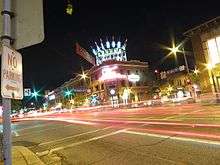Lake Street (Minneapolis)

Lake Street is a major east-west thoroughfare in Minneapolis, Minnesota which is located between 29th and 31st Streets in south Minneapolis. It was named such because it runs through the Chain of Lakes area on the west side of town and passes over a small channel linking Lake Calhoun and Lake of the Isles.
West of the city limits, Lake Street is coextensive with Minnetonka Boulevard running nearly a mile into St. Louis Park and then separates from Minnetonka Boulevard (which continues westward all the way through St. Louis Park) and runs diagonally southwestward. In the Uptown commercial district, the road is one-way and paired with Lagoon Avenue one block to the north to improve traffic flow. The street runs eastward past Interstate 35W and State Highway 55 (Hiawatha Avenue) to the Mississippi River where it crosses the Lake Street-Marshall Bridge into St. Paul and becomes Marshall Avenue.
Demographics
Lake Street has attracted immigrants over the course of its history, and was a major center for the early Scandinavian culture of the city. The headquarters for the Sons of Norway fraternal organization is one remnant of this, located along Lake Street in Uptown, a block west of its intersection with Hennepin Avenue. Today, Mexican culture dominates along much of the roadway, particularly near and east of Interstate 35W.
Boundaries and neighborhoods
Lake Street has historically and, in the late 20th century, become the official boundary of several Minneapolis neighborhoods. From west to east these include: Cedar-Isles-Dean, East Isles, East Calhoun, Lowry Hill East, CARAG, Whittier, Lyndale, Central, Phillips West, Midtown, Powderhorn Park, East Phillips, Corcoran and Longfellow.
West of Interstate 35W, Lake Street is considered trendy and upscale. Informal commercial districts begin at the Lake Calhoun area which marks the end of West Lake Street, followed by Uptown, and then by Lyn-Lake. These areas generally have high property values and fairly high density. In the early 20th century this was one of the busiest areas outside of downtown as the streetcars headed west to Lake Minnetonka. Today they are among the most popular entertainment and nightlife areas in South Minneapolis, and the site of rapid condominium development in recent years.
The section of Lake Street stretching from Interstate 35W to Hiawatha Avenue has been in the past known for crime, prostitution, and drugs, especially in the late 1980s and early '90s. The street marks the southern boundary of the Phillips neighborhood, which was plagued with violence during that time. However, there has been reinvestment in the corridor, as most of this section of the corridor was branded with the Midtown neighborhood name. East Lake Street continues to undergo massive refitting to help reduce crime, boost property values, and attract more shoppers. Improvements to the area brought concerns for the many immigrant business and property owners on the street who are being assessed for the new sidewalks and street paving. Nonpositive gentrification was also a concern. An example of renewed interest in the area is the refurbishment of the Midtown Exchange building at East Lake Street and Chicago Avenue South. Formerly one of the most notoriously crime-ridden intersections in the city, is now home to an Allina Hospitals and Clinics expansion that brought 1,500 new employees to the area; the Sheraton Minneapolis Midtown Hotel and the Midtown Global Market with a wide variety of shopping, dining, events and rental.
The METRO Blue Line light-rail (also known as the Hiawatha Light Rail line) corridor meets Lake Street at Hiawatha Avenue, and has been another reason for investment in the area. The station itself is one of the most expensive along the line because it had to be elevated above a busy intersection. Furthermore, the Lake Street station has become one of the most crime-ridden stops along the Blue Line. Beginning in August 2012, police have increased patrols, added 24 new high definition cameras, and even added classical music in an effort to deter troublemakers. [1] Lake Street has undergone a major upgrade, its first in half a century. Some have proposed adding light rail to Lake Street since it is a major bus corridor (streetcar service previously existed until the 1950s). Others have suggested adding a streetcar line either to Lake Street or to the Midtown Greenway about a block to the north, a former freight rail bed that has been converted into a pedestrian and bicycle path.
East of Hiawatha Avenue, Lake Street stretches through the Longfellow and Cooper neighborhoods. This section represents the last remnants of Scandinavian investment for which Longfellow is well known. Recent investment in eastern Minneapolis includes new development at the corner of West River Parkway and East Lake Street, anchoring the Lake Street-Marshall Bridge. This area is populated with middle-class homes and businesses, with property values rising as the street approaches the Mississippi River.
Automobile era effects
During the auto era, Lake Street had the greatest number of gas stations and car dealerships in the city. In the mid-1970s, the construction of a K-Mart closed off Nicollet Avenue at Lake Street and combined two city blocks. Many traditional streetcar-era buildings were razed during the auto era and much of Lake Street contains 1960s-era auto-oriented businesses with parking lots. A Target store and Cub Foods grocery store at opposite corners of Minnehaha Avenue and Lake Street also caused controversy for the pros and cons of this investment and typical suburban configuration with wide parking lot instead of an urban adaptation.
Talks have begun on a new reconfigured site that reopens Nicollet Avenue to Lake Street. Efforts to redevelop more multi-use and density have been successful. Public investment and private redevelopment has occurred throughout the Lake Street corridor with a new public library near Minnehaha Avenue and the new mixed-use anchor building, Midtown Exchange, previously mentioned.
References
- ↑ Minnesota Public Radio. "Hey, classical music is only human (5x8 - 8/7/12)". Retrieved 2012-08-08.
External links
Coordinates: 44°56′54.2″N 93°13′46″W / 44.948389°N 93.22944°W